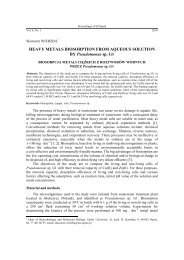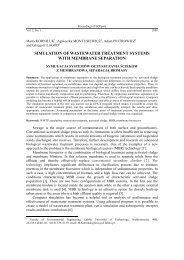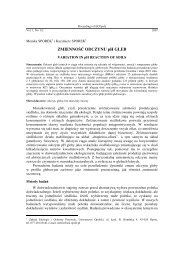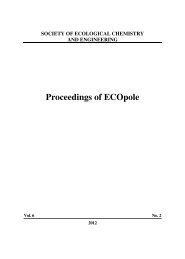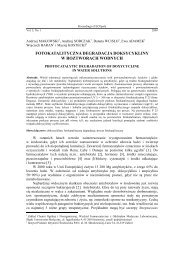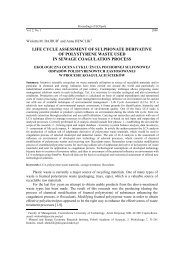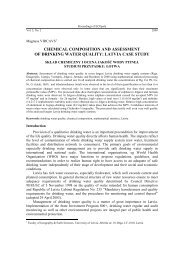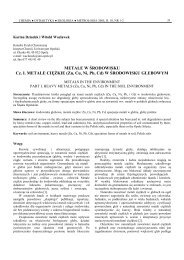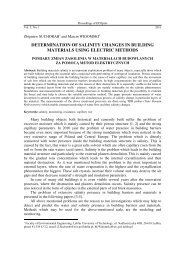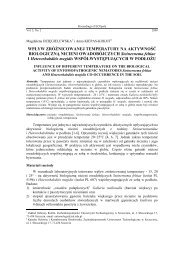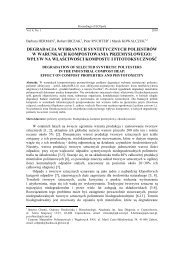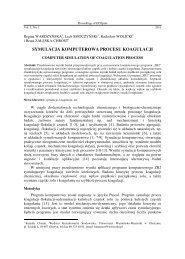disinfective activity of 8-hydroxyquinoline sulfate on moulds
disinfective activity of 8-hydroxyquinoline sulfate on moulds
disinfective activity of 8-hydroxyquinoline sulfate on moulds
You also want an ePaper? Increase the reach of your titles
YUMPU automatically turns print PDFs into web optimized ePapers that Google loves.
354<br />
Małgorzata Nabrdalik<br />
as: Alternaria tenuissima, Aspergillus flavus, Cladosporium cladosporioides, Penicillium<br />
notatum, Stachybotrys chartarum.<br />
In the tests for fungicidal <str<strong>on</strong>g>activity</str<strong>on</strong>g>, the efficacy <str<strong>on</strong>g>of</str<strong>on</strong>g> 8-<str<strong>on</strong>g>hydroxyquinoline</str<strong>on</strong>g> <str<strong>on</strong>g>sulfate</str<strong>on</strong>g> was<br />
tested in 6 working c<strong>on</strong>centrati<strong>on</strong>s <str<strong>on</strong>g>of</str<strong>on</strong>g>: 0.01, 0.1, 0.25, 0.5, 0.75 and 1.0%.<br />
The fungicidal <str<strong>on</strong>g>activity</str<strong>on</strong>g> <str<strong>on</strong>g>of</str<strong>on</strong>g> 8-<str<strong>on</strong>g>hydroxyquinoline</str<strong>on</strong>g> <str<strong>on</strong>g>sulfate</str<strong>on</strong>g> was assessed <strong>on</strong> the basis <str<strong>on</strong>g>of</str<strong>on</strong>g>: the<br />
cylinder-plate diffusi<strong>on</strong> method, the intensity <str<strong>on</strong>g>of</str<strong>on</strong>g> mycelial growth rate and the ability <str<strong>on</strong>g>of</str<strong>on</strong>g><br />
spores to germinate.<br />
Fungicidal <str<strong>on</strong>g>activity</str<strong>on</strong>g> <str<strong>on</strong>g>of</str<strong>on</strong>g> the chemical applied was assessed with the modified cylinderplate<br />
diffusi<strong>on</strong> method. The dishes were poured with 20 cm 3 <str<strong>on</strong>g>of</str<strong>on</strong>g> Sabourauda medium<br />
inoculated with particular <strong>moulds</strong> species and the mixture <str<strong>on</strong>g>of</str<strong>on</strong>g> the spores <str<strong>on</strong>g>of</str<strong>on</strong>g> the tested <strong>moulds</strong><br />
(<str<strong>on</strong>g>of</str<strong>on</strong>g> 1×10 6 cell/cm 3 density). The wells were filled with 0.2 cm 3 <str<strong>on</strong>g>of</str<strong>on</strong>g> the tested chemical in<br />
respective c<strong>on</strong>centrati<strong>on</strong>s. The c<strong>on</strong>trol treatment was the wells filled with sterile water. The<br />
samples were incubated at 25 o C for 3 weeks. The <str<strong>on</strong>g>disinfective</str<strong>on</strong>g> efficacy <str<strong>on</strong>g>of</str<strong>on</strong>g> the tested<br />
chemical was assessed <strong>on</strong> the basis <str<strong>on</strong>g>of</str<strong>on</strong>g> the growth inhibiti<strong>on</strong> z<strong>on</strong>es.<br />
The indicati<strong>on</strong> <str<strong>on</strong>g>of</str<strong>on</strong>g> fungicidal <str<strong>on</strong>g>activity</str<strong>on</strong>g> based <strong>on</strong> the intensity <str<strong>on</strong>g>of</str<strong>on</strong>g> mycelial growth rate was<br />
c<strong>on</strong>ducted <strong>on</strong> Sabourauda medium with the additi<strong>on</strong> <str<strong>on</strong>g>of</str<strong>on</strong>g> the c<strong>on</strong>secutive c<strong>on</strong>centrati<strong>on</strong>s <str<strong>on</strong>g>of</str<strong>on</strong>g><br />
the chemical. Agar discs <str<strong>on</strong>g>of</str<strong>on</strong>g> 10 mm diameter overgrown with 2-week mycelium <str<strong>on</strong>g>of</str<strong>on</strong>g> tested<br />
<strong>moulds</strong> were placed <strong>on</strong> the medium <strong>on</strong> Petri dishes. The c<strong>on</strong>trol treatment was prepared <strong>on</strong><br />
a Petri dish with Sabourauda medium (without the chemical) and mycelium disc. The<br />
diameter <str<strong>on</strong>g>of</str<strong>on</strong>g> mould col<strong>on</strong>ies was measured every 3 days, from the beginning <str<strong>on</strong>g>of</str<strong>on</strong>g> the mycelial<br />
growth recorded in the c<strong>on</strong>trol dishes. The samples were incubated at 25°C.<br />
The <str<strong>on</strong>g>activity</str<strong>on</strong>g> <str<strong>on</strong>g>of</str<strong>on</strong>g> tested chemical against the mycelial growth was assessed <strong>on</strong> the basis <str<strong>on</strong>g>of</str<strong>on</strong>g> the<br />
growth rate index (T), calculated with the following formula [3, 4]:<br />
A b1<br />
b<br />
T = + + ... +<br />
D d d<br />
where: T - growth rate index, A - the mean value <str<strong>on</strong>g>of</str<strong>on</strong>g> col<strong>on</strong>y diameter measurement [mm],<br />
D - the length <str<strong>on</strong>g>of</str<strong>on</strong>g> an experiment [days], b1, b2, bx - increase in diameter since the last<br />
measurement, d1, d2, dx - number <str<strong>on</strong>g>of</str<strong>on</strong>g> days passed since the last measurement.<br />
Indicati<strong>on</strong> <str<strong>on</strong>g>of</str<strong>on</strong>g> fungicidal <str<strong>on</strong>g>activity</str<strong>on</strong>g> was also tested <strong>on</strong> the basis <str<strong>on</strong>g>of</str<strong>on</strong>g> the spores’ ability to<br />
germinate. For this purpose 0.02 cm 3 <str<strong>on</strong>g>of</str<strong>on</strong>g> the c<strong>on</strong>secutive c<strong>on</strong>cetrati<strong>on</strong>s <str<strong>on</strong>g>of</str<strong>on</strong>g><br />
8-<str<strong>on</strong>g>hydroxyquinoline</str<strong>on</strong>g> <str<strong>on</strong>g>sulfate</str<strong>on</strong>g> were placed <strong>on</strong> the 1 cm 2 <str<strong>on</strong>g>of</str<strong>on</strong>g> the slide. After drying, preparati<strong>on</strong>s<br />
were inoculated with 0.02 cm 3 <str<strong>on</strong>g>of</str<strong>on</strong>g> the suspensi<strong>on</strong> c<strong>on</strong>taining spores <str<strong>on</strong>g>of</str<strong>on</strong>g> the tested <strong>moulds</strong>.<br />
The density <str<strong>on</strong>g>of</str<strong>on</strong>g> inoculum was selected in a way that in the field <str<strong>on</strong>g>of</str<strong>on</strong>g> visi<strong>on</strong> under a medium<br />
magnificati<strong>on</strong> <str<strong>on</strong>g>of</str<strong>on</strong>g> a microscope 50÷60 spores were observed. The germinati<strong>on</strong> <str<strong>on</strong>g>of</str<strong>on</strong>g> 50 spores<br />
was assessed after 24 hours in the field <str<strong>on</strong>g>of</str<strong>on</strong>g> visi<strong>on</strong> under a microscope. When rating<br />
germinati<strong>on</strong>, the scale from 0 to 4 introduced by Burgieł [3, 4] was used.<br />
The influence <str<strong>on</strong>g>of</str<strong>on</strong>g> tested chemicals <strong>on</strong> the development <str<strong>on</strong>g>of</str<strong>on</strong>g> mould spores was assessed <strong>on</strong> the<br />
basis <str<strong>on</strong>g>of</str<strong>on</strong>g> the spores germinati<strong>on</strong> index, calculated with the formula:<br />
1<br />
( n × a)<br />
× 100<br />
=<br />
× 4<br />
∑ I<br />
N<br />
where: I - spores germinati<strong>on</strong> index, n - number <str<strong>on</strong>g>of</str<strong>on</strong>g> the spores in the specific grade <strong>on</strong> the<br />
scale, a - grade <strong>on</strong> the scale, N - general number <str<strong>on</strong>g>of</str<strong>on</strong>g> the counted spores, 4 - the highest grade<br />
<str<strong>on</strong>g>of</str<strong>on</strong>g> the scale.<br />
x<br />
x



